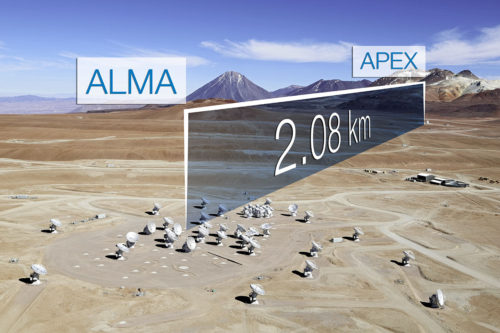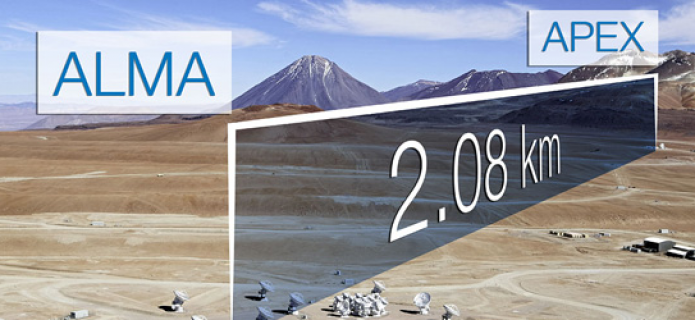ALMA Gains New Capability in its First VLBI Observation
5 March, 2015 / Read time: 4 minutes
The Atacama Large Millimeter/submillimeter Array (ALMA) recently combined its immense collecting area and sensitivity with that of the APEX (Atacama Pathfinder Experiment) Telescope to create a new, single instrument through a process known as Very Long Baseline Interferometry (VLBI). In VLBI, data from two independent telescopes are combined to form a virtual telescope that spans the geographic distance between them, yielding extraordinary magnifying power.
The new ALMA/APEX observation, which took place on January 13, was an essential proof-of-concept test for the planned Event Horizon Telescope (EHT), which eventually will include a global network of millimeter-wavelength telescopes. When fully assembled, the EHT – with ALMA as the largest and most sensitive site – will form an Earth-size telescope with the magnifying power required to see details at the edge of the supermassive black hole at the center of the Milky Way.
For this first-of-its-kind observation, ALMA and the nearby APEX telescope simultaneous studied a quasar known as 0522-364 – a distant galaxy commonly used for testing in radio astronomy due to its remarkable brightness. To ensure the telescopes were in sync, ALMA used its newly installed and exquisitely precise atomic clock (see ALMA announcement) to time-code the data as it was collected. This is essential for VLBI because it enables data taken at different geographical locations on different telescopes to be precisely matched and accurately integrated.

ALMA, the Atacama Large Millimeter/submillimeter Array, has successfully combined its immense collecting area and sensitivity with that of APEX (Atacama Pathfinder Experiment) to create a new, single instrument through a process known as Very Long Baseline Interferometry (VLBI). This first successful observation using VLBI with ALMA used a baseline of 2.1 km, and was an essential proof-of-concept test for the planned Event Horizon Telescope, which eventually will include a global network of millimetre-wavelength telescopes. Crédito: Clem & Adri Bacri-Normier (wingsforscience.com)/ESO.
The full dataset from the observing run was captured on hard drives and flown back to MIT where it will undergo full analysis. Due to the vast amount of information collected, air travel is the fastest means of data transmission, even faster than the fastest international Internet connection.
"The entire team is immensely gratified at achieving this success on the first VLBI attempt with ALMA. It marks a huge step toward making first images of a black hole with the Event Horizon Telescope," said Shep Doeleman, the principal investigator of the ALMA Phasing Project and assistant director of the Massachusetts Institute of Technology's Haystack Observatory.
This most recent work was carried out by a team made up of members from the ALMA Phasing Project, the Joint ALMA Observatory, the Smithsonian Astrophysical Observatory and the APEX Telescope.
More information
The Atacama Large Millimeter/submillimeter Array (ALMA), an international astronomy facility, is a partnership of the European Organisation for Astronomical Research in the Southern Hemisphere (ESO), the U.S. National Science Foundation (NSF) and the National Institutes of Natural Sciences (NINS) of Japan in cooperation with the Republic of Chile. ALMA is funded by ESO on behalf of its Member States, by NSF in cooperation with the National Research Council of Canada (NRC) and the National Science Council of Taiwan (NSC) and by NINS in cooperation with the Academia Sinica (AS) in Taiwan and the Korea Astronomy and Space Science Institute (KASI).
ALMA construction and operations are led by ESO on behalf of its Member States; by the National Radio Astronomy Observatory (NRAO), managed by Associated Universities, Inc. (AUI), on behalf of North America; and by the National Astronomical Observatory of Japan (NAOJ) on behalf of East Asia. The Joint ALMA Observatory (JAO) provides the unified leadership and management of the construction, commissioning and operation of ALMA.
Contact:
Valeria Foncea
Education and Public Outreach Officer
Joint ALMA Observatory
Santiago, Chile
Tel: +56 2 467 6258
Cell: +56 9 75871963
Email: [email protected]
Charles E. Blue
Public Information Officer
National Radio Astronomy Observatory
Charlottesville, Virginia, USA
Tel: +1 434 296 0314
Cell: +1 434.242.9559
E-mail: [email protected]
Richard Hook
Public Information Officer, ESO
Garching bei München, Germany
Tel: +49 89 3200 6655
Cell: +49 151 1537 3591
Email: [email protected]
Masaaki Hiramatsu
Education and Public Outreach Officer, NAOJ Chile
Observatory Tokyo, Japan
Tel: +81 422 34 3630
E-mail: [email protected]

